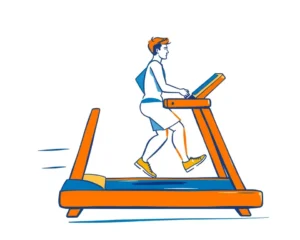The teenage years, a period of rapid physical, social, and emotional development, are increasingly intertwined with the digital world. As adolescents navigate the complexities of identity formation, social relationships, and academic pressures, online communication has become an integral part of their daily lives. But how does this constant connectivity impact their mental health and cardiorespiratory fitness (CRF)? Emerging research seeks to understand these relationships, particularly during the critical ages of 15 to 17.
The Digital Landscape of Adolescence
For teenagers, online communication is more than just a pastime; it’s a primary mode of interaction. Social media, instant messaging, and online gaming platforms offer avenues for connection, self-expression, and access to information. However, this digital immersion also presents potential risks.
The Double-Edged Sword of Social Media
Social media use has been linked to both positive and negative outcomes for adolescent mental health. On the one hand, it can facilitate social support, foster a sense of belonging, and provide access to valuable resources. On the other hand, excessive social media use has been associated with:
- Increased risk of mental health problems: Studies indicate that adolescents who spend more than three hours a day on social media face double the risk of experiencing symptoms of depression and anxiety.
- Body image dissatisfaction: The curated and often unrealistic portrayals of bodies online can lead to negative self-perception and body image issues, especially among girls.
- Lowered self-esteem: Constant social comparison and the pressure to maintain a perfect online persona can contribute to feelings of inadequacy and low self-esteem.
- Cyberbullying: Online harassment and bullying can have severe consequences for mental well-being.
- Sleep disruption: Late-night social media use can interfere with sleep patterns, which are crucial for adolescent mental health and cognitive function.
The Importance of Cardiorespiratory Fitness
Cardiorespiratory fitness (CRF), reflecting the efficiency of the heart and lungs in delivering oxygen to the body during physical activity, is a key indicator of overall health. For adolescents, adequate CRF is essential for:
- Physical health: Reducing the risk of obesity, cardiovascular disease, and other chronic conditions.
- Mental health: Promoting positive mood, reducing stress, and improving cognitive function.
- Academic achievement: Supporting concentration, memory, and learning.
Unfortunately, studies suggest that only about 40% of adolescents have healthy CRF levels.
Untangling the Web: Online Communication, Mental Health, and Cardiorespiratory Fitness
The relationship between online communication, mental health, and CRF is complex and multifaceted. Research suggests several potential pathways through which these factors interact:
Online Communication and Mental Health: A Closer Look
- Time Displacement: Excessive time spent online may displace opportunities for physical activity, face-to-face interactions, and other activities that promote mental well-being.
- Social Comparison Theory: Social media platforms often encourage users to compare themselves to others, which can lead to feelings of inadequacy, envy, and depression.
- Cyberbullying and Online Harassment: These negative online experiences can have a significant impact on mental health, leading to anxiety, depression, and even suicidal thoughts.
- Sleep Disturbance: The blue light emitted from electronic devices can interfere with the production of melatonin, a hormone that regulates sleep. Lack of sleep can exacerbate mental health problems.
Cardiorespiratory Fitness and Mental Health: A Virtuous Cycle
- Neurobiological Effects: Physical activity and CRF have been shown to increase the production of endorphins and other neurochemicals that have mood-boosting effects.
- Stress Reduction: Exercise can help to reduce stress hormones and promote relaxation.
- Improved Self-Esteem: Achieving fitness goals and experiencing the physical benefits of exercise can enhance self-esteem and body image.
- Social Interaction: Participating in sports or other physical activities can provide opportunities for social interaction and support, which can buffer against mental health problems.
The Interplay: A Holistic Perspective
The relationship between online communication, mental health, and CRF is not simply a matter of cause and effect. These factors are interconnected and influence each other in complex ways. For example, adolescents who are struggling with mental health issues may be more likely to withdraw from physical activity and spend more time online, creating a negative feedback loop.
Longitudinal Studies: Tracking Changes Over Time
To better understand these complex relationships, researchers are increasingly turning to longitudinal studies, which follow individuals over extended periods, collecting data at multiple time points. This approach allows researchers to examine how changes in online communication, CRF, and mental health are related to each other over time.
Key Findings from Longitudinal Research
- Declining CRF: Some studies have observed a decline in CRF among adolescents over time, potentially linked to increased screen time and decreased physical activity.
- Worsening Mental Health: There is evidence suggesting that mental health challenges, such as depression and anxiety, are becoming more prevalent among adolescents.
- The CRF-Mental Health Link: Research consistently demonstrates a positive association between CRF and mental health, with higher levels of CRF being linked to fewer symptoms of depression and anxiety.
- Gender Differences: Some studies have found that the relationship between CRF and mental health may be stronger in girls than in boys.
- The Role of Screen Time: Screen time, including time spent on social media, has been identified as a potential mediator between CRF and mental health.
Implications for Intervention
The findings from longitudinal studies have important implications for intervention and prevention efforts. Strategies to promote adolescent mental health and well-being should address both online communication habits and physical activity levels.
Strategies for Promoting Positive Outcomes
Given the potential risks and benefits of online communication, mental health, and CRF, it is crucial to develop strategies that promote positive outcomes for adolescents.
Promoting Healthy Online Communication Habits
- Limit Screen Time: Encourage adolescents to set limits on their daily screen time and to take breaks from electronic devices.
- Promote Critical Thinking: Teach adolescents to critically evaluate online content and to be aware of the potential for social comparison and unrealistic portrayals.
- Encourage Positive Online Interactions: Foster a culture of respect and empathy online, and encourage adolescents to engage in positive and supportive online interactions.
- Address Cyberbullying: Implement policies and programs to prevent and address cyberbullying.
- Prioritize Real-World Connections: Encourage adolescents to maintain strong relationships with friends and family offline.
Boosting Cardiorespiratory Fitness
- Promote Physical Activity: Encourage adolescents to engage in regular physical activity, such as sports, dancing, or simply walking or biking to school.
- Make Exercise Fun: Find activities that adolescents enjoy and that fit into their lifestyles.
- Set Realistic Goals: Help adolescents set realistic fitness goals and celebrate their achievements.
- Provide Support: Offer encouragement and support to adolescents as they work to improve their CRF.
- Limit Sedentary Behavior: Reduce time spent sitting or lying down, such as watching television or playing video games.
Addressing Mental Health Concerns
- Promote Mental Health Awareness: Educate adolescents about mental health and reduce the stigma associated with seeking help.
- Provide Access to Mental Health Services: Ensure that adolescents have access to affordable and confidential mental health services.
- Teach Coping Skills: Help adolescents develop healthy coping skills for dealing with stress, anxiety, and depression.
- Encourage Open Communication: Create a safe and supportive environment where adolescents feel comfortable talking about their feelings.
- Involve Parents and Educators: Engage parents and educators in promoting adolescent mental health and well-being.
The Road Ahead: Future Directions
Research on the relationship between online communication, mental health, and CRF is ongoing. Future studies should focus on:
- Longitudinal Studies: Conducting more longitudinal studies to track changes over time and to examine the long-term effects of online communication and CRF on mental health.
- Mediation and Moderation Analyses: Investigating the mechanisms through which online communication and CRF influence mental health.
- Intervention Studies: Developing and evaluating interventions to promote positive online communication habits, increase CRF, and improve adolescent mental health.
- Specific Online Activities: Examining the effects of specific online activities, such as social media use, online gaming, and video streaming, on mental health and CRF.
- Diverse Populations: Conducting research with diverse populations of adolescents to understand how these relationships may vary across different groups.
Conclusion
The teenage years are a critical period for development, and the choices adolescents make during this time can have a lasting impact on their mental and physical health. By understanding the complex relationships between online communication, mental health, and CRF, we can develop strategies to promote positive outcomes for all adolescents. It’s about finding a balance – leveraging the benefits of online communication while mitigating the risks, and prioritizing physical activity to foster both a healthy body and a healthy mind.







